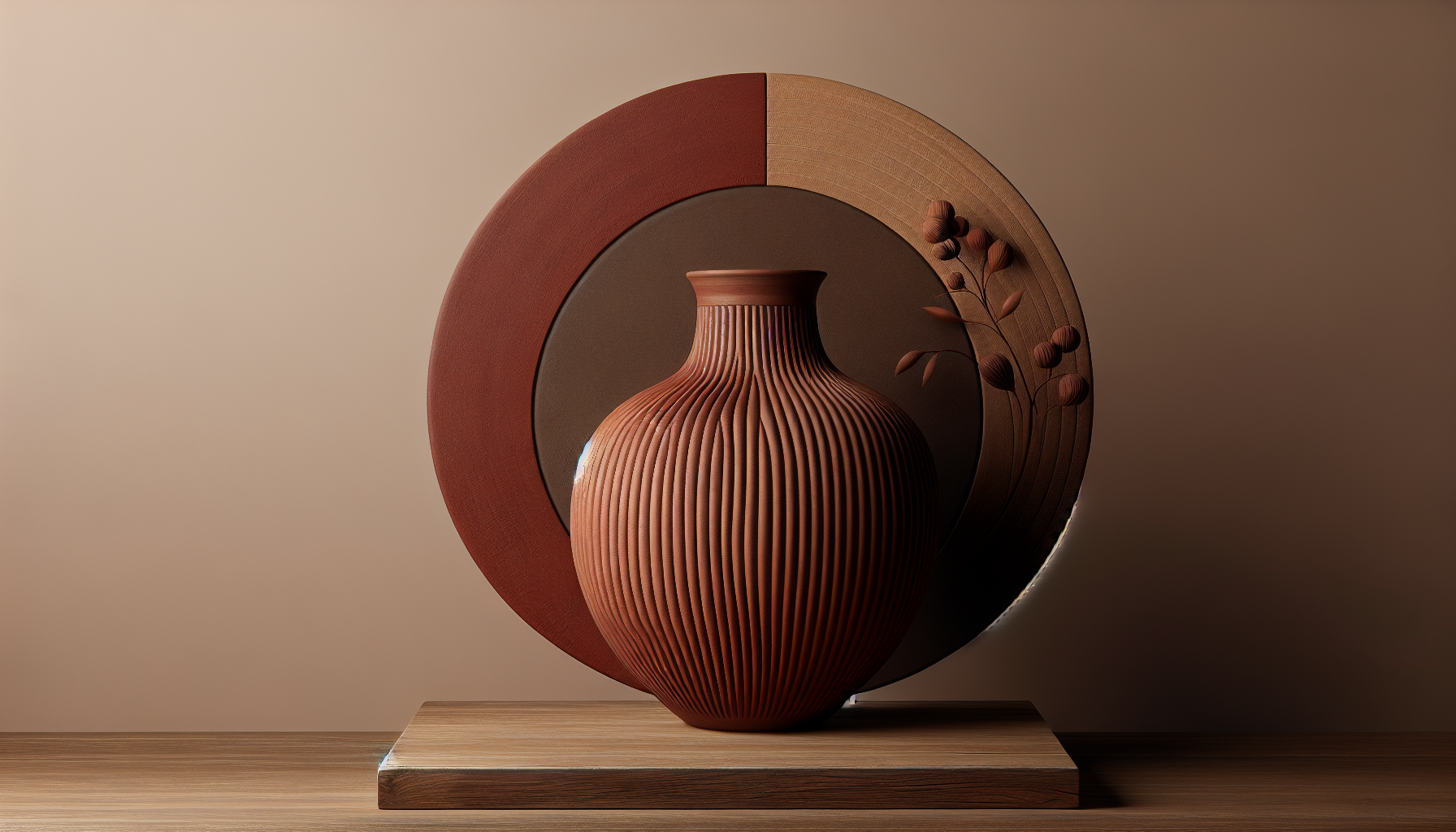What do you envision when you think of home decor? Are you drawn to clean lines, minimalism, and warmth? If so, you might find yourself intrigued by the enchanting blend of Japanese and Scandinavian design known as Japandi. What adds a unique twist to this charming style is the use of terracotta tones. Let’s unpack how these earthy colors can transform your space while complementing the sleekness of Japandi aesthetics.
Understanding Japandi Style
Japandi style is a harmonious fusion of Japanese minimalism and Scandinavian functionality. The core of this design philosophy rests on simplicity, natural materials, and a connection to nature. You’ll notice an emphasis on handmade and artisan pieces, as well as a palette inspired by the earth and natural elements.
Key Features of Japandi Style
- Minimalism: Elements are pared down to only the essentials, fostering a sense of serene tranquility.
- Natural Materials: Wood, bamboo, and stone are commonly woven into decor, establishing a soothing ambiance.
- Muted Palette: Soft, muted colors, often with a focus on neutral shades as well as deep greens and browns.
- Functionality: Scandinavian influences promote practicality, ensuring that every piece serves a purpose while looking aesthetically pleasing.
By combining these elements, you create a peaceful retreat that invites relaxation and mindfulness.
Terracotta Tones: A Rich Earthy Palette
Terracotta tones resonate with warmth and earthiness, making them an ideal match for Japandi style. Think of deep reds, warm oranges, and soft browns that invoke the richness of the earth. These hues can breathe life into the minimalism of Japandi, providing a grounding effect that fosters comfort and warmth.
Characteristics of Terracotta Colors
- Warmth: The earthy tones create a cozy environment, making spaces feel inviting and welcoming.
- Versatility: Terracotta adapts well to various styles, seamlessly blending with other colors and materials.
- Natural Aesthetic: Reflecting the beauty of nature, terracotta tones promote wellness and connection.
The combination of Japandi’s clean aesthetics and terracotta’s warmth creates an inviting atmosphere that nurtures both body and mind.
Can Japandi Style Work with Terracotta Tones?
Absolutely! Incorporating terracotta tones into Japandi style adds warmth and richness, enhancing the overall aesthetic. Not only do these colors complement the minimalist approach, but they also bring a touch of personality and vibrancy to your home.
Benefits of Combining Japandi and Terracotta
- Enhanced Warmth: The infusion of terracotta tones creates a hospitable environment, transforming your space into a retreat.
- Balanced Aesthetics: The warmth from terracotta can offset the coolness of minimalist decor, striking a harmonious balance.
- Textural Variation: Mixing surfaces, such as smooth wood with rough terracotta, adds layers and depth to your design.
This combination presents an excellent opportunity to express your style while maintaining a serene atmosphere.
How to Incorporate Terracotta Tones in Japandi Style
Now that you understand how beautifully these two styles can coexist, let’s discuss practical ways you can introduce terracotta tones into your Japandi decor.
1. Wall Colors
Consider painting your walls in a muted terracotta hue. This sets a grounded tone for the rest of the room and pairs fabulously with wooden furniture. If you’re not up for a complete transformation, use terracotta as an accent wall to draw attention without overwhelming your space.
2. Terracotta Pottery
Using terracotta pots for plants can reinforce a connection to nature while adding to the earthy palette. Incorporate them with greenery, and you’ll instantly enhance the organic feel of your space. The contrast between the green of the plants and the warm tones of the terracotta is visually pleasing.
3. Textiles and Accessories
Introduce terracotta through textiles such as cushions, throws, or curtains. Look for organic fabrics that speak to the Japandi ethos. Consider incorporating terracotta-printed pieces that maintain clean lines and simple designs.
4. Terracotta Flooring
If you’re looking for a more permanent option, terracotta tiles or flooring can create an inviting foundation. Pair these with light wood furniture to keep the balance. An olive green or soft cream rug can further enhance the visual appeal of the space.
5. Art and Decor
Include wall art or decor items featuring terracotta tones. You might find woven wall hangings, paintings, or framed prints that highlight these colors. Select pieces that follow the simplistic guidelines of Japandi design to ensure harmonious integration.
6. Accent Furniture
Look for minimalistic furniture pieces that feature terracotta accents—like a side table or a decorative chair. This layered approach adds depth without cluttering your space.
Color Combinations for Japandi and Terracotta
Understanding how to mix and match colors can significantly enhance the beauty of your interior. Here’s a table to guide you on effective color combinations:
| Terracotta Shade | Ideal Complementary Color | Description |
|---|---|---|
| Deep Terracotta | Dusty Blue | Creates a calming contrast, reminiscent of sunsets. |
| Warm Rust | Soft Cream | Brightens the space while maintaining warmth. |
| Earthy Orange | Sage Green | This duo evokes a peaceful, natural ambiance. |
| Light Terracotta | Charcoal Gray | Adds sophistication and depth with a modern twist. |
These combinations help maintain the understated elegance of Japandi while celebrating the cozy aspects of terracotta.
Selecting Furniture in Japandi Style
Now that you’re inspired to incorporate terracotta, let’s discuss how to select furniture that aligns with both styles.
Key Features to Look For
- Natural Materials: Opt for pieces made from wood, rattan, or bamboo, as these materials resonate with both the Japandi and terracotta aesthetics.
- Simple Silhouettes: Choose furniture that boasts clean lines and minimal ornamentation. Focus on functionality without sacrificing beauty.
- Warm Tones: Look for furniture in warm woods that harmonize with terracotta hues, enhancing that inviting feel.
Textures: Creating Depth and Warmth
Adding various textures can make your space dynamic and layered. This aspect is particularly important when merging the coolness of Japandi with the warmth of terracotta.
Textural Elements to Introduce
- Natural Fibers: Incorporate rugs, blankets, and curtains made from wool, cotton, or linen for a cozy touch.
- Ceramic Accents: Use terracotta or ceramic vases and bowls. These can be functional as well as artistic, serving as conversation starters.
- Wood: Emphasize natural wood grain in your furniture and accents. This ties together the warm tones while aligning with Japandi style.
Mixing these elements will pull the whole room together while keeping things inviting and harmonious.
Lighting: Enhancing Japandi and Terracotta
Lighting plays a vital role in setting the tone of your space. It can highlight terracotta tones while keeping the ambiance calm and serene.
Tips for Lighting
-
Natural Light: Keep window treatments light to allow natural sunlight to flood in. Sunlight enhances the warm tones of terracotta, creating an inviting atmosphere.
-
Soft Ambient Lighting: Select fixtures that emit soft lighting, such as paper lanterns, which resonate with Japandi’s calming essence.
-
Accent Lighting: Use spotlights or table lamps sparingly to draw attention to key decor pieces without overwhelming the simplicity of the design.
The right lighting not only improves visibility but also enhances the warmth and beauty of your decor.
Accessories: Personalizing Your Space
While maintaining the functionality and simplicity of Japandi, accessories can still add a personal touch.
Thoughtful Accessory Choices
-
Plants: Incorporate small indoor plants or succulents in terracotta pots to keep things lively while adhering to the natural theme.
-
Art & Prints: Curate a selection of artwork, keeping the terracotta color scheme in mind. Consider minimalist prints that echo both styles.
-
Textiles: Use different textures and patterns for cushions or throws, ensuring that they remain within the color palette you’ve established.
By carefully selecting accessories, you can make your space feel personal and lived in, while still embracing the Japandi style.
Overcoming Common Challenges
Every decor style comes with its challenges, and blending Japandi with terracotta is no exception. Here are some common pitfalls and how to avoid them.
Chic vs. Cluttered
It’s easy to get carried away when blending styles. Aim to keep surfaces clear and only include items that hold significance or beauty, maintaining the simplicity at the core of Japandi.
Balancing Warmth and Minimalism
You might find that your space feels too warm or too minimalist. Assess the balance by experimenting with colors, textures, and furniture layouts until you find what feels right for you.
Fitting Within a Space
Smaller spaces may seem limiting, but they can work beautifully with Japandi and terracotta. Choose multifunctional furniture and accessories that make the most of your area without crowding it.
What’s important is that you tailor your space to reflect your personality and lifestyle while maintaining harmony in design.
Final Thoughts on Japandi and Terracotta
You now have a solid grasp of how Japandi style seamlessly integrates with the warmth of terracotta tones. The combination fosters a tranquil and inviting space perfect for relaxation and creativity. By focusing on natural materials, soft colors, and the right accessories, your home can embody the calm and functionality of Japandi while celebrating the comforting hues of terracotta.
Remember that your space should reflect you and your story. Embrace experimentation and let your creative flair shine through every detail. A comfortable home is not just about aesthetics; it’s about creating an environment that nurtures you.

